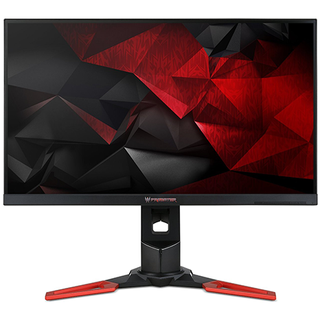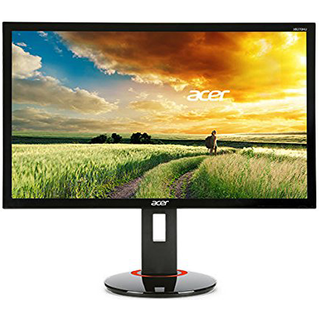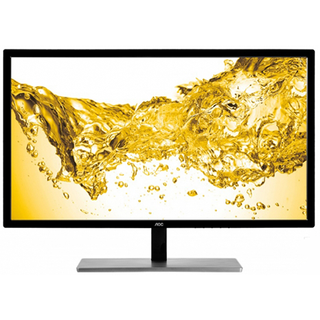Acer Predator XB321HK 32-inch Ultra HD G-Sync Monitor Review
Today we’re looking at Acer’s latest flagship gaming monitor, the Predator XB321HK. Sporting a 32-inch IPS screen, G-Sync and premium build quality; it looks like just the thing for a cost-no-object gaming rig.
Why you can trust Tom's Hardware
Brightness And Contrast
To read about our monitor tests in depth, please check out Display Testing Explained: How We Test Monitors and TVs.Brightness and Contrast testing is covered on page two.
Uncalibrated – Maximum Backlight Level
Including the Predator XB321HK, we still only have five Ultra HD gaming monitors in our database – ViewSonic’s XG2700-4K and AOC’s U2879VF (FreeSync); plus Acer’s XB280HK and XB271HK (G-sync). To bring the count up to six, we included Asus’ ROG Swift PG279Q, a QHD 165Hz G-sync monitor.
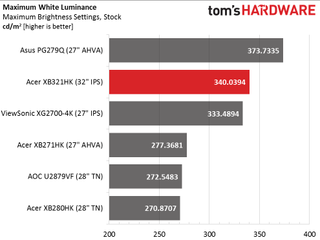
High brightness is not a trait of many Ultra HD screens but the XB321HK has more output than most. Here it’s only exceeded by the Asus QHD panel. Acer claims 350cd/m2 but we couldn’t quite get there with our sample.
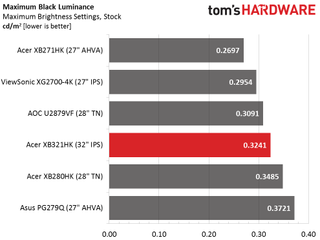
Black levels are also not a strong suit of high-res monitors. Acer’s smaller Predator, the XB271HK takes the win here, but the others aren’t too far behind. We anxiously await the day AMVA panels acquire Ultra HD resolution in the gaming category.
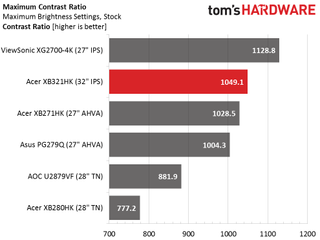
Overall contrast is decent at 1049.1:1. But this comes at the expense of some color inaccuracy at lower saturation levels; and there’s a gamma issue that requires lowering the contrast control to fix. Will this be a problem? Read on to find out.
Uncalibrated – Minimum Backlight Level

The backlight’s minimum output is an ideal 55.0293cd/m2. If you like to game in the dark, just drop the slider to zero and enjoy. The XB321HD and PG279Q are ideally configured for this. The other screens get just a little too dark. OK, the ViewSonic is a lot too dark.
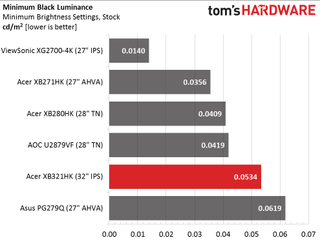
The ViewSonic posts a very low black level number, but that isn’t indicative of superior contrast. The XB321HK remains solidly in the hunt.

Contrast remains consistent throughout the jumbo-Predator’s backlight range. It also seems the IPS screens outclass the TN samples in both tests. There’s a reason gamers prefer the tech; and we do too.
After Calibration to 200cd/m2
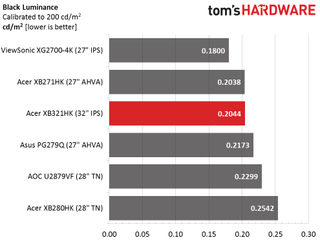
It seems that calibration hasn’t affected the XB321HK’s black level performance. All we did was lower the contrast slider, change the gamma preset from 2.2 to 1.8, and drop the blue slider one click.
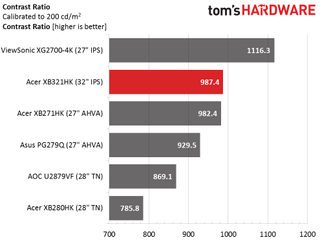
The final contrast value is only 6% down from the max result. Obviously the contrast slider adjustment exacts no penalty, and that’s a relief. Most monitors would not tolerate such a significant adjustment. 40 is probably where the control should be set from the factory.
ANSI Contrast Ratio
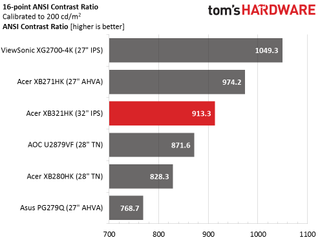
ANSI contrast drops a little more but not too much. Our XB321HK sample doesn’t have the very best uniformity but intra-image contrast still looks good both to our instruments and to our eyes. The panel part appears to be of high quality.
Current page: Brightness And Contrast
Prev Page OSD Setup And Calibration Next Page Grayscale Tracking And Gamma ResponseStay on the Cutting Edge
Join the experts who read Tom's Hardware for the inside track on enthusiast PC tech news — and have for over 25 years. We'll send breaking news and in-depth reviews of CPUs, GPUs, AI, maker hardware and more straight to your inbox.

Christian Eberle is a Contributing Editor for Tom's Hardware US. He's a veteran reviewer of A/V equipment, specializing in monitors. Christian began his obsession with tech when he built his first PC in 1991, a 286 running DOS 3.0 at a blazing 12MHz. In 2006, he undertook training from the Imaging Science Foundation in video calibration and testing and thus started a passion for precise imaging that persists to this day. He is also a professional musician with a degree from the New England Conservatory as a classical bassoonist which he used to good effect as a performer with the West Point Army Band from 1987 to 2013. He enjoys watching movies and listening to high-end audio in his custom-built home theater and can be seen riding trails near his home on a race-ready ICE VTX recumbent trike. Christian enjoys the endless summer in Florida where he lives with his wife and Chihuahua and plays with orchestras around the state.
-
Bartendalot The nite about 4K@60hz being obsolete soon is a valid one and makes the purchase price even more difficult to swallow.Reply
I'd argue that my 1440p@144hz is a more future-proof investment. -
Yaisuah I have this monitor and think its great and almost worth the money, but I want to point out that nobody on the internet seems to realize there's a perfect resolution between 1440 and 4k that looks great and runs great and I think it would be considered 3k. Try adding 2880 x 1620 to your resolutions and see how it looks on any 4k monitor. I run windows and most less intensive games at this resolution and constantly get 60fps with a 970(around 30fps at 4k). You also don't have to mess with windows scaling on a 32in monitor. After seeing how great 3k looks and runs, I really don't know why everyone immediately jumped to 4k.Reply -
mellis I am still going to wait before getting a 4K monitor, since there is still not a practical solution for 4K gaming. In a couple of more years hopefully 4K monitors will be cheap and midrange GPUs will be able to support gaming on them. I think trying to invest in 4K gaming now is a wait of money. Sticking with 1080p for now.Reply -
truerock A 4K@120Hz G-Sync video monitor based PC rig under $4,000 is probably 2 to 3 years away.Reply -
RedJaron Reply
I would hazard a few guesses. First would be that 2880x1620 is so close to 2560x1440 that no manufacturer wants to complicate product lines like that.18346905 said:I have this monitor and think its great and almost worth the money, but I want to point out that nobody on the internet seems to realize there's a perfect resolution between 1440 and 4k that looks great and runs great and I think it would be considered 3k. Try adding 2880 x 1620 to your resolutions and see how it looks on any 4k monitor. I run windows and most less intensive games at this resolution and constantly get 60fps with a 970(around 30fps at 4k). You also don't have to mess with windows scaling on a 32in monitor. After seeing how great 3k looks and runs, I really don't know why everyone immediately jumped to 4k.
Second, 2160 is the least common multiple of both 720 and 1080, meaning it's the lowest resolution that's a perfect integer scalar of both. So with proper upscaling, a 720 or 1080 source picture can be displayed reasonably well on a 4K display. These panels are made for TVs as well as computer monitors, and the majority of TV signal ( at least in the US ) is still in either 720p or 1080p. Upscaling 1080 to 1620 is the same as upscaling 720 to 1080 ( they're both a factor of 150% ). Upscaling by non-integer factors means you need a lot of pixel interpolation and anti-aliasing. To me, this looks very fuzzy ( I bought a 720p TV over a 1080 TV years ago because playing 720p PS3 games and 720p cable TV on a 1080p display looked horrible to me ). So it may be the powers that be decided on the 4K resolution so that people could adopt the new panels and still get decent picture quality with the older video sources ( at least until, or if, they get upgraded ). If so, I can agree with that. -
michalt I have one and have not regretted my purchase for a second. I tend to keep monitors for a long time (my Dell 30 inch displays have been with me for a decade). When looked at over that time period, it's not that expensive for something I'll be staring at all day every day.Reply -
photonboy It would be nice to offer a GLOBAL FPS LOCK to stay in asynchronous mode at all times regardless how high the FPS gets.Reply -
photonboy Update: AMD has this, not sure where it is for NVidia or if the GLOBAL FPS LOCK is easy to do.Reply
